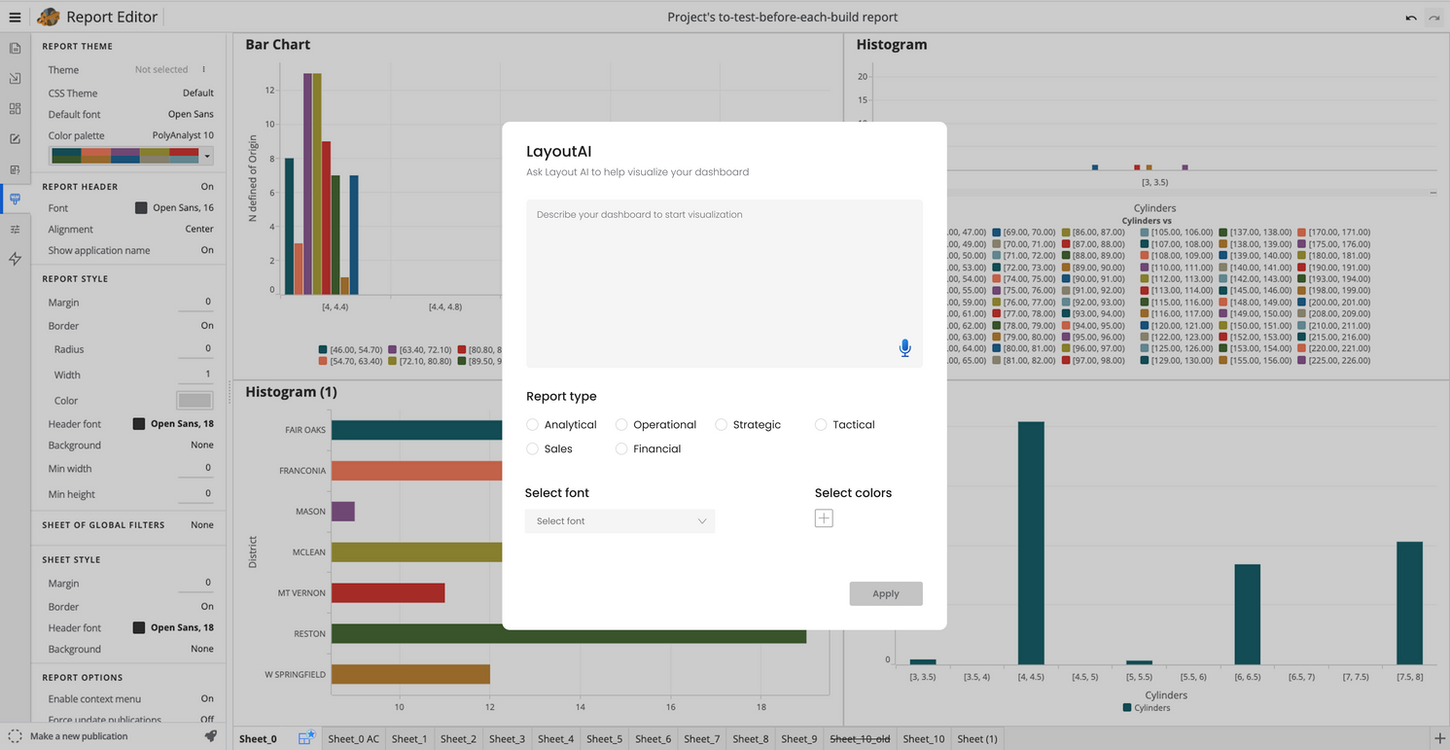LayoutAI
A comprehensive human-centered AI research & design
EMPLOYER
Megaputer Intelligence Inc.
TEAM
Human-centered AI researcher (me). This is an independent UX case study to explore the possibilities of AI
YEAR & DURATION
2025_ 2 weeks
OUTCOME
Defined guidelines & designed an adaptive AI-driven tool that removes repetitive layout decisions, allowing data analysts to concentrate on insights rather than interface design
Introduction
This independent project explores how Human-Centered AI (HCAI) Design principles can improve dashboard usability. While working with Host Layout, a dashboard design feature at Megaputer Intelligence, I observed opportunities to reduce repetitive, time-consuming layout tasks using AI
Although this project was not part of my workplace deliverables and has not been launched, I used it as a research and design exercise to demonstrate how I can apply HCAI guidelines to design AI-driven features.
The result is LayoutAI — a conceptual assistant that generates intelligent, user-friendly report dashboard layouts
Context & Problem
The Tool
Host Layout allows analysts to build dashboards by manually arranging components such as charts, filters, and tables
Observed Pain Points
-
Users often struggle with repetitive, manual placement of components
-
Non-designers find it challenging to produce visually balanced dashboards
-
The absence of starting guidance slows down workflow efficiency
-
Opportunity
Opportunity: Could AI generate helpful starting layouts and adapt to user preferences, enabling analysts to focus more on insights rather than interface details?
Human-Centered AI Design Process
I grounded my design process in Human-Centered AI Design guidelines, ensuring the AI would remain transparent, trustworthy, and user-controlled
Key Steps:
-
Exploration: Studied HCAI principles and reviewed dashboard usability challenges
-
Define Needs: Targeted automation for low-risk, high-repetition tasks (like alignment and spacing)
-
Pattern Discovery: Mapped common layout patterns from repeated user behaviors
-
Feedback Loop: Designed a cycle where users correct AI layouts, and the system learns from adjustments
-
Trust & Transparency: Planned features to explain why a layout suggestion was made in plain language
The Solutions
Layout AI: Let the AI arrange your dashboard while you focus on insights
LayoutAI is an AI-powered assistant embedded into Host Layout (A blank canvas to begin creating a report dashboard). It helps users by generating smart starting layouts that can be customized and improved over time

LayoutAI feature
The user activates LayoutAI from the dashboard toolbar

LayoutAI menu
-
They select preferences
-
LayoutAI generates one or more layout options
-
Users can accept, tweak, or reject suggestions

LayoutAI trust
The AI provides an explanation of its decision
Key Features
-
Automated starting point: Saves time and reduces repetitive work
-
Adjustable parameters: Tailors layouts to different goals
-
Learning loop: Adapts to user corrections and preferences
-
Transparency panel: Builds trust by explaining rationale
Human-Centered Principles Applied
I deliberately aligned LayoutAI with HCAI best practices:
-
Transparency: Users can see why the AI made each suggestion
-
User control: Every AI output can be edited or dismissed
-
Trust: Confidence indicators (“highly confident layout”) guide expectations
-
Accessibility & inclusion: Considered whitespace, alignment, and readability for diverse audiences
-
Ethical awareness: Highlighted risks of biased training data (e.g., over-reliance on certain layout aesthetics)
What I Achieved
I applied Human-Centered AI Design to a real-world workflow. This project demonstrates my ability to research, design, and communicate AI-powered solutions responsibly
I learned:
-
Transparency builds user confidence in AI-driven features
-
How to balance automation with user control
-
Automation is most valuable when focused on repetitive, low-risk tasks
-
Empathy is critical: designing for non-experts requires simplicity and clear explanations
